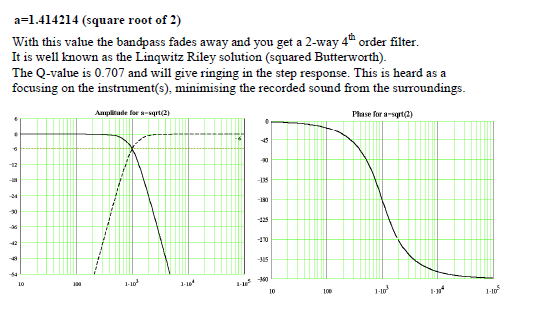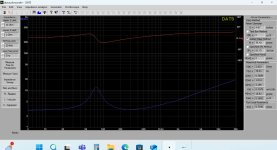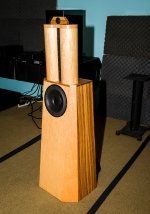Hi all. An acquaintance procured some Dynaudio car woofers and is obsessed with building conventional 2 ways with them. I am looking for the flow chart to help begin this journey. I am currently recovering from back surgery and I have to find my t/s parameters but i honestly have no starting point. does anyone have a thought flow process in achieving this goal? Thanks in advance
Greets!
Measure T/S specs if not supplied and proven accurate, then:
T/S max flat alignment:
Vented net volume (Vb) (L) = 20*Vas*Qts'^3.3
(Ft^3 = (Vb)/~28.31685)
Vented box tuning (Fb) (Hz) = 0.42*Fs*Qts'^-0.96
Load in a program such as WinISD, Hornresp or similar to find vent design specs
Measure T/S specs if not supplied and proven accurate, then:
T/S max flat alignment:
Vented net volume (Vb) (L) = 20*Vas*Qts'^3.3
(Ft^3 = (Vb)/~28.31685)
Vented box tuning (Fb) (Hz) = 0.42*Fs*Qts'^-0.96
Load in a program such as WinISD, Hornresp or similar to find vent design specs
I bet you end up with pretty big closed enclosures. Dynaudio + ported, that doesn’t add up very often.
Ok, thanks for the replies. Can I please ask. I do not know what t/s max flat alignment is. Can you assume ported speakers from the fact that they are dynaudio automotive speakers? Thanks
Flat alignment or response allows a speaker to sound like a real musical instrument. People from the car world are often looking for the buzz and boom, which is not hi-fidelity at all. Most bands and orchestras do not sound like buzz and boom. Look at this chart from a Peavey SP2(2004) speaker which is flat +- 3 db 54 hz 17.5 khz. The amplitude upper left is pretty flat which means it can not only sound like a singer/songwriter playing wood guitar, it can sound like a top quality piano, cymbal, tinkly bells, or pipe organ. Harmonic Distortion upper right means frequencies double and triple the real sound are not added very much. Another number describing the ability to reproduce real sounds accurately. Go listen to a Steinway grand at a concert or church, then try CD tracks of the same piano on various speakers. The first speaker I've owned that passes that test is this one. There are others, but not sold in my iiny flyover city of 2000000. If your hearing stops at 5000 hz the way most US male's does, you will not able to tell the difference.
Thiel Small parameters are numbers that driver manufacturers put on their datasheets to describe how you would enclose them for best accuracy. VAS, Fs, Qt, sensitivity, watt limit, max excursion. Drivers you pick up at the scrapyard do not come with such parameters. You can test a driver you found to produce those numbers yourself, but it is a lot of work. Requires a $100 microphone, a mike stand, a interface to PC or laptop (mixer with phantom power), a quiet room to test in, an amp, some software like REW running on your PC or laptop. I'd rather buy the drivers from a shop with the numbers already measured, saves a lot of time. People have found more inexpensive drivers the T/S parameters vary more from unit to unit, and others have found the T/S parameters do not settle in to the datasheet value until the driver has been run a number of hours.
Thiel Small parameters are numbers that driver manufacturers put on their datasheets to describe how you would enclose them for best accuracy. VAS, Fs, Qt, sensitivity, watt limit, max excursion. Drivers you pick up at the scrapyard do not come with such parameters. You can test a driver you found to produce those numbers yourself, but it is a lot of work. Requires a $100 microphone, a mike stand, a interface to PC or laptop (mixer with phantom power), a quiet room to test in, an amp, some software like REW running on your PC or laptop. I'd rather buy the drivers from a shop with the numbers already measured, saves a lot of time. People have found more inexpensive drivers the T/S parameters vary more from unit to unit, and others have found the T/S parameters do not settle in to the datasheet value until the driver has been run a number of hours.
Attachments
Last edited:
What are the model numbers?Hi all. An acquaintance procured some Dynaudio car woofers and is obsessed with building conventional 2 ways with them. I am looking for the flow chart to help begin this journey. I am currently recovering from back surgery and I have to find my t/s parameters but i honestly have no starting point. does anyone have a thought flow process in achieving this goal? Thanks in advance
Search Dynaudio
https://dynaudio.com/car-audio/history#:~:text=1997,production car – developed by Dynaudio.
https://web.archive.org/web/20130626084956/https://www.gattiweb.com/dynaudio.html
https://www.rgsound.it/prodotti/atch/20070904193552_Mobile.pdf
https://web.archive.org/web/2020011...media/2510/dyn_automotive_brochure_int_dp.pdf
==
youtube diy 2 way Dynaudio MW162 + Davisluis (?) Davidlouis Tweeter
post#21 crossover 17w75xl d28
I look forward to hearing how it turns out. I don't think you need any more than your ears as measuring equipment here. 😀
This is the theory with fitting filters together:

Just had a nagging thought the tweeter may need negative polarity with a steepish rolloff Dynaudio driver. I use crimp tags to connect drivers to the wiring...
This is the theory with fitting filters together:
Just had a nagging thought the tweeter may need negative polarity with a steepish rolloff Dynaudio driver. I use crimp tags to connect drivers to the wiring...
same crossover 17w75xl d28
http://audioclone.free.fr/focus.html
Last edited:
Awww- Look at all of those t/s parameters you have lucked in to! No bucket for you!
Keep in mind that the result will only be a accurate as the t/s parameters match the exact unit you have. There will also be second order and real world effects that cannot be predicted by the "simulation". Plots from WinISD will give you a lot of information, but not allow you to actually hear the end result until you are locked into an expensive built cabinet. The bucket sounds stupid, but it's nice to be able to experiment with a little more or less volume to dial in the exact sound/performance you want, plus it's a nice preview before you commit it to wood.
A pox on the manufacturer for not keeping this information available for their legacy products. Bloody bean counters. Thank goodness for the Wayback Machine!!
Keep in mind that the result will only be a accurate as the t/s parameters match the exact unit you have. There will also be second order and real world effects that cannot be predicted by the "simulation". Plots from WinISD will give you a lot of information, but not allow you to actually hear the end result until you are locked into an expensive built cabinet. The bucket sounds stupid, but it's nice to be able to experiment with a little more or less volume to dial in the exact sound/performance you want, plus it's a nice preview before you commit it to wood.
A pox on the manufacturer for not keeping this information available for their legacy products. Bloody bean counters. Thank goodness for the Wayback Machine!!
more Dynaudio-
https://web.archive.org/web/20070704082757/http://www.dynaudio.com/eng/auto/mobile/md330d.php
kits at the bottom- drivers, crossovers, boxes
https://web.archive.org/web/20130626084956/https://www.gattiweb.com/dynaudio.html
https://web.archive.org/web/20070704082757/http://www.dynaudio.com/eng/auto/mobile/md330d.php
kits at the bottom- drivers, crossovers, boxes
https://web.archive.org/web/20130626084956/https://www.gattiweb.com/dynaudio.html
Last edited:
To all thanks. I have been sent the sticker on this woofer. The Volvo code is 30752352 and I presume the dynaudio is bq7ta. From memory, dynaudio had no info on this speaker. As I am bedridden, ill put the info out there. It seems that ebay has interest in the repurposing of dynaudio Volvo and vw drivers.
https://www.ebay.com/itm/155216031517
Volvo 30752352


built in crossover

Since you are recovering, tell your friend to mount the speakers on a simple open baffle & add a powered subwoofer.
https://duckduckgo.com/?q=open++baffle+diy+speakers&t=osx&iar=images&iax=images&ia=images

Volvo 30752352
built in crossover
Since you are recovering, tell your friend to mount the speakers on a simple open baffle & add a powered subwoofer.
https://duckduckgo.com/?q=open++baffle+diy+speakers&t=osx&iar=images&iax=images&ia=images
I think the average Joe on here with 30 db hot subs fall into the same category. Eq can return high q systems to flat regardless. If you use any tone controls for customizing it to taste, your system isn’t flat and by your definition, not accurate. You are also assuming that the recording is flat too which it never is.Flat alignment or response allows a speaker to sound like a real musical instrument. People from the car world are often looking for the buzz and boom, which is not hi-fidelity at all. Most bands and orchestras do not sound like buzz and boom.
Pop rock disco techno house rap music, maybe. Only the recording engineer knows what the band were trying to achieve. Classical music the main tone control was deleting <55 hz to keep the needle from jumping out of the groove on those wood consoles. Classical fans expect the recording to sound like the wood & metal instruments on stage. I own wood pianos (1982 sohmer 39, 1940 steinway 40), and I bought my last $600 speakers to sound like that. No tone controls on classical music. Pop & rock on that speaker sounds fine. Live pop & rock concerts are no reference because the audience is talking and singing over the music. I was in rural Kansas during the disco era (like country or stay home) and house techno etc, I do not listen to more than 100 seconds.If you use any tone controls for customizing it to taste, your system isn’t flat and by your definition, not accurate. You are also assuming that the recording is flat too which it never is.
Last edited:
Those plots in post 15 appear to be phase and impedance only. Non-interesting except for crossover design. Amplitude at 1 w 1 m on an infinite (large) wall would be interesting.
With the info provided, are any of the t/s parameters, or impedence curves providing any blurred outline of what the end product will look like?
First, test your hearing with $25 headphones and software. If you cannot hear above 7000 hz like most developed world males, then there is no sense spending money to reproduce those frequencies.
There is the scientific approach, measuring T/S values. Requires the equipment listed in post # 5. Plus a quiet room, and some software. The name of the software, look on the software thread for a post about measuring T/S value.
There is the "take a guess and listen to the result" method. Since these drivers came from a car door, you could estimate the interior volume of a car door. Then build a box to match the volume. Listen then criticize the result. I took the second approach with found drivers I use in my TV room. I built a box approximately the size of the volume behind the drivers In the projection TV they came out of. I used cardboard. At 2 watts (13 watt limit the driver has printed on it) the cardboard does not audibly vibrate. Works okay. At least as good as the used speakers from cheap home systems sold at the charity resale shop. Most units, better. Lots of cheap plastic speakers look like they are 7:" diameter, but actually they contain a 2" woofer. The drivers I salvaged from a projection TV sitting on the curb for garbage are actually 6 1/2" diameter.
There is the scientific approach, measuring T/S values. Requires the equipment listed in post # 5. Plus a quiet room, and some software. The name of the software, look on the software thread for a post about measuring T/S value.
There is the "take a guess and listen to the result" method. Since these drivers came from a car door, you could estimate the interior volume of a car door. Then build a box to match the volume. Listen then criticize the result. I took the second approach with found drivers I use in my TV room. I built a box approximately the size of the volume behind the drivers In the projection TV they came out of. I used cardboard. At 2 watts (13 watt limit the driver has printed on it) the cardboard does not audibly vibrate. Works okay. At least as good as the used speakers from cheap home systems sold at the charity resale shop. Most units, better. Lots of cheap plastic speakers look like they are 7:" diameter, but actually they contain a 2" woofer. The drivers I salvaged from a projection TV sitting on the curb for garbage are actually 6 1/2" diameter.
- Home
- Loudspeakers
- Multi-Way
- Build a conventional 2 way speaker



